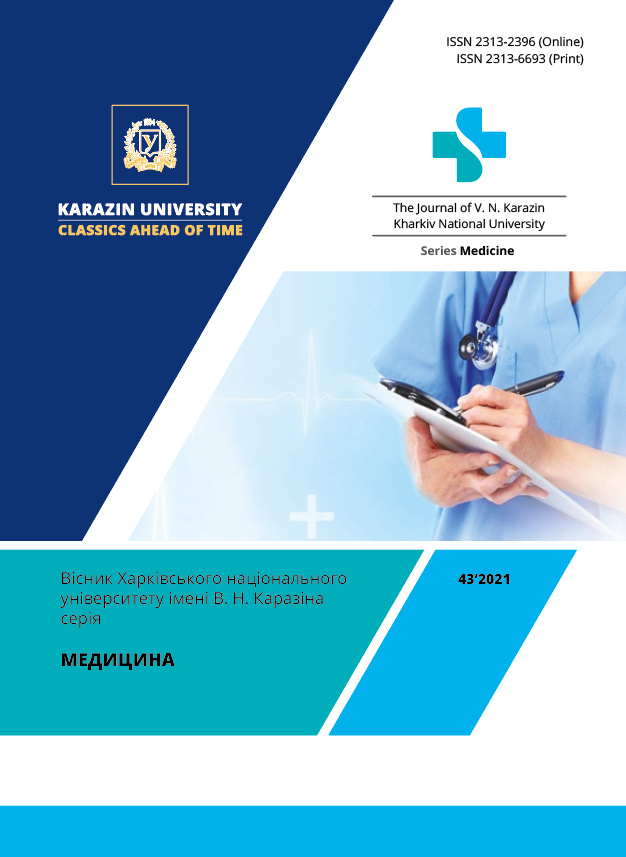Prevalence of post-covid syndrome among inhabitants of Kharkiv
Abstract
Introduction. Currently, the coronavirus pandemic remains high on the world community, and it is discussed on a daily basis, posing a serious threat. Despite the fact, that most people recover from coronavirus infection, many suffer from the manifestations of the post-COVID syndrome that became a significant social problem due to disruption the normal lifestyle and daily functioning, reduced quality of life. The fact, that the development of the mechanism of post-COVID conditions has not been studied much is a challenge for medical community, so its efforts should be aimed at the analysis of these mechanisms. Objective: to assess the prevalence of post-COVID symptoms among residents of Kharkiv and to provide recommendations regarding the management of such patients. Materials and methods. The study involved 60 respondents, including 43 females and 17 males, all participants were older than 20 years. Using a self-designed questionnaire applying in Google Docs, the incidence of symptoms due to post-COVID syndrome was assessed among all respondents, as well as separately among males and females, and depending on the time since the disease, whether physical activity remained at the same level, and, also whether such patients seek medical help. Results. The study has shown the primary role of tiredness and fatigue, it was noted by 37 respondents (61.7 %), difficulty thinking and concentrating (so-called «foggy brain») – 35 participants (58.3 %), decrease the exercise tolerance – 34 respondents (56.7 %), muscle pain – 27 respondents (45 %), sleep disorders and joint pain at the same level – 26 respondents (43.3 %). The gender-specific was analyzed, so there were some differences. It was found that physical activity in 35 respondents (58.3 %) was decreased that leads to hypodynamy resulting in a reduced quality of life. Conclusion. Bearing this in mind, the authors consider it necessary to create a comprehensive rehabilitation plan with the participation of a physical therapist and other professionals, using the recommendations of reputable institutions such as the National Institute for Health and Care Excellence (NICE) and the Centers for Disease Control and Prevention (CDC).
Downloads
References
Iwu CJ, Iwu CD, Wiysonge CS. The occurrence of long COVID: a rapid review. Pan Afr Med J. 2021 Jan 20; 38: 65. Doi: https://doi.org/10.11604/pamj.2021.38.65.27366. PMID: 33889231; PMCID: PMC8028365.
Al-Jahdhami I, Al-Naamani K, Al-Mawali A. The Post-acute COVID-19 Syndrome (Long COVID). Oman Med J. 2021 Jan 26; 36 (1):e220. Doi: https://doi.org/10.5001/omj.2021.91. PMID: 33537155; PMCID: PMC7838343.
Centers for Disease Control and Prevention (Internet). Updated July 9, 2021. https://www.cdc.gov/coronavirus/2019-ncov/hcp/clinical-care/post-covid-conditions.html
Global World Health Organization. [Internet]. WHO/2019-nCoV/Post_COVID-19_condition/Clinical_case_definition/2021.1
Kuehn BM. Post–COVID-19 Symptoms Were Worse Than Cancer’s Effects. JAMA. 2021; 326 (8): 692. Doi: https://doi.org/10.1001/jama.2021.12353
Nalbandian A, Sehgal K, Gupta A, Madhavan MV, McGroder C, Stevens JS, et al. Post-acute COVID-19 syndrome. Nat Med. 2021; 27: 601–15. pmid:33753937
Pavlia А, Theodoridoub M, Maltezou H. Post-COVID Syndrome: Incidence, Clinical Spectrum, and Challenges for Primary Healthcare Professionals. Archives of Medical Research. 2021; 52 (6): 575–581. Doi: https://doi.org/10.1016/j.arcmed.2021.03.010
Taquet M, Dercon Q, Luciano S, Geddes J, Husain M, Harrison P. Incidence, co-occurrence, and evolution of long-COVID features: A 6-month retrospective cohort study of 273,618 survivors of COVID-19. PLoS Med 18(9): e1003773. Doi: https://doi.org/10.1371/journal.pmed.100377
World Health Organization. Global covid-19 clinical platform case report form (CRF) for post covid condition (Post COVID-19 CRF). [Internet]. 9 Feb 2021. https://www.who.int/publications/i/item/global-covid-19-clinical-platform-case-report-form-(crf)-for-post-covid-conditions-(post-covid-19-crf-)
10. Centers for Disease Control and Prevention [Internet]. https://www.cdc.gov/coronavirus/2019-ncov/hcp/clinical-care/post-covid-management.html
Venkatesan P. NICE guideline on long COVID. Lancet Respir Med. 2021 Feb; 9 (2): 129. Doi: https://doi.org/10.1016/S2213-2600(21)00031-X. Epub 2021 Jan 13. PMID: 33453162; PMCID: PMC7832375.
Mayer KP, Steele AK, Soper MK, Branton JD, Lusby ML, Kalema AG, Dupont-Versteegden EE, Montgomery-Yates AA. Physical Therapy Management of an Individual With Post-COVID Syndrome: A Case Report. Phys Ther. 2021 Jun 1; 101 (6): pzab098. Doi: https://doi.org/10.1093/ptj/pzab098. PMID: 33735380; PMCID: PMC7989151.
Daynes E, Gerlis C, Chaplin E, Gardiner N, Singh SJ. Early experiences of rehabilitation for individuals post-COVID to improve fatigue, breathlessness exercise capacity and cognition – A cohort study. Chron Respir Dis. 2021 Jan–Dec; 18: 14799731211015691. Doi: https://doi.org/10.1177/14799731211015691. PMID: 33957805; PMCID: PMC8114752.
The Journal of V. N. Karazin Kharkiv National University, series Medicine has following copyright terms:
- Authors retain copyright and grant the journal right of first publication with the work simultaneously licensed under a Creative Commons Attribution License that allows others to share the work with an acknowledgement of the work’s authorship and initial publication in this journal.
- Authors are able to enter into separate, additional contractual arrangements for the non-exclusive distribution of the journal’s published version of the work, with an acknowledgement of its initial publication in this journal.
- Authors are permitted and encouraged to post their work online prior to and during the submission process, as it can lead to productive exchanges, as well as earlier and greater citation of published work.




